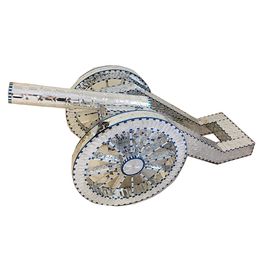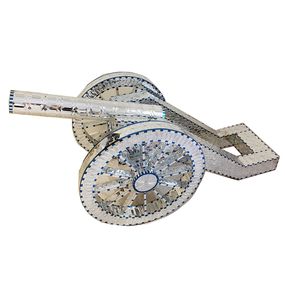
Presentation
"Stucco, wood and mirror work were the great specialties of Iranian masonry masters. Facade and interior decoration were central to Iranian art and architecture. In Iran, the sacred architecture is majestic and precious. When you stand in front of their facades with carved mirrors, all the beauty of their traditional design changes and evolves according to the image of the person who is reflected and which you must try to identify through the scattered fragments of carved mirrors.
Architecture brings you to an introspection of oneself. Military weapons, tanks, cannons and fighter planes, with their abstract and strong forms also look magnificent. However, their function is to reduce the human body to death and to shred bodies. My idea of making "weapons covered by cut mirrors" and sublimate them to give them another dimension, preferably in full size, with a cover of hand-cut mirrors reminiscent of ancient sacred buildings.
The sacred vision of the war that has been so destructive to me and to my country and the world in which I live. In fact, these works of art are the visualization of everyday events in my own life. It's unconscious, I prefer to look backwards as I look back at my life, and especially religion, to see them attractive. This discrepancy between a magnified object and the original subject of the work is simply magnificent at a normal distance, and this incoherence between tenderness and beauty against danger is the same incoherence with which I live."
- Mehdi Nabavi
Read more
Architecture brings you to an introspection of oneself. Military weapons, tanks, cannons and fighter planes, with their abstract and strong forms also look magnificent. However, their function is to reduce the human body to death and to shred bodies. My idea of making "weapons covered by cut mirrors" and sublimate them to give them another dimension, preferably in full size, with a cover of hand-cut mirrors reminiscent of ancient sacred buildings.
The sacred vision of the war that has been so destructive to me and to my country and the world in which I live. In fact, these works of art are the visualization of everyday events in my own life. It's unconscious, I prefer to look backwards as I look back at my life, and especially religion, to see them attractive. This discrepancy between a magnified object and the original subject of the work is simply magnificent at a normal distance, and this incoherence between tenderness and beauty against danger is the same incoherence with which I live."
- Mehdi Nabavi
All artworks of Mehdi Nabavi

Discover our selections of works by artists
Need help finding your favorite? Consult our selection pages made for you.
Need to know more?
What are their 3 main works?
When was Mehdi Nabavi born?
The year of birth of the artist is: 1978

